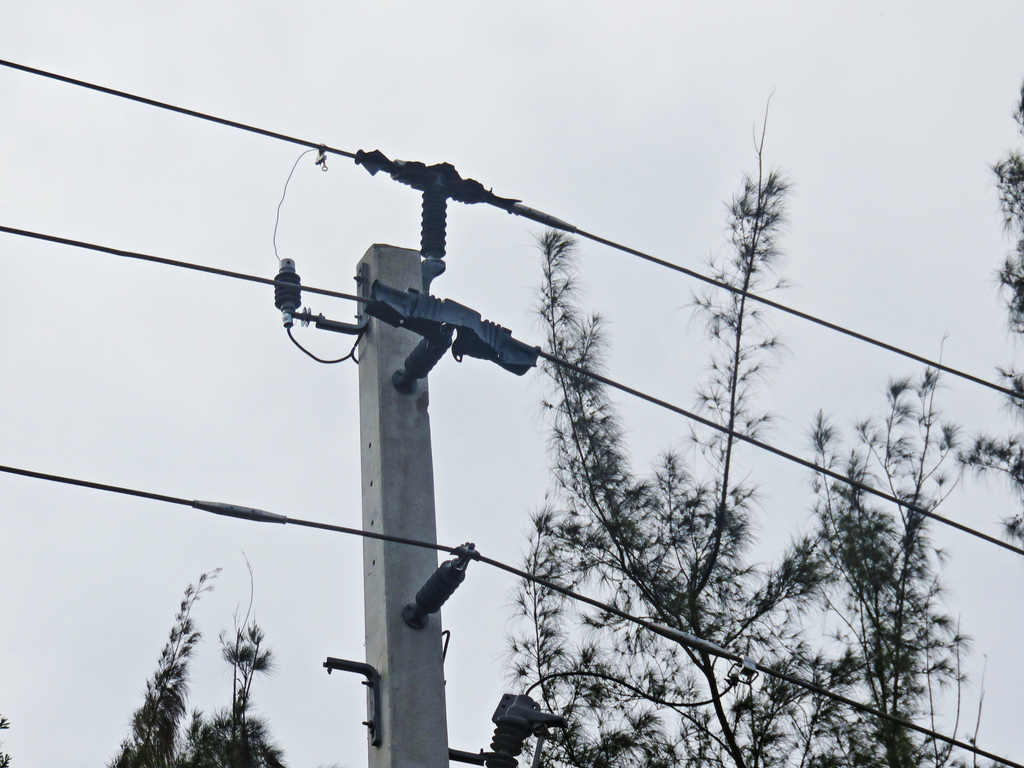Bald Eagles of Broward County, Florida
› ARCHIVED Pembroke Pines OBSERVATIONS & PHOTOS FROM PRIOR NESTING SEASONS
›
ARCHIVED 2017-2018 Observations of Pembroke Pines Bald Eagle Nest BO-002
Raptor excluders not yet installed on power lines in front of nest
Raptor excluders not yet installed on power lines in front of nest
|
Administrator
|
This post was updated on .
Although this is not a sighting report I wish to express my concern about the lack of raptor guards on the power poles in front of the Pines Boulevard eagle nest. Hurricane Irma caused damage or loss of the insulator caps and conductor covers which had been in place since FPL installed them shortly after they learned of the nest.
This photo, which I took back in 2009 shows the unprotected high voltage lines which run about 150 feet in front of the eagle nest. Given their 8 foot wingspan, eagles could easily complete a circuit if they fly into them or roost on a lower strand. Electrocution and vehicle collisions are the major causes of death of juvenile urban eagles.Note the eagle flying in the distance, as well as the yellow spirals installed to increase the visibility of the wires:  Here is an example of the raptor protectors on one side of a power pole west of the nest site, as it appeared on November 1, 2017.  One or more eaglets has hatched at the nest, and I am concerned that while they are learning to fly (in about 2 months from now) they may try to land on top of the power poles. I am not entirely knowledgeable about the subject, but believe that the conductor covers and insulator caps, (perhaps along with deterrent guards) may reduce the chance of electrocution. I have seen the fledgling eagles land on the top of the poles and even (briefly) on the top wire. FPL has been very careful to avoid disturbance of the nest. They installed the yellow spiral attachments "curley-Q's" which enhance visibility of the wires. This step alone was one of the most important ways to protect the eagles. I am sure FPL still has much work to undo the damage inflicted by the hurricane. Hopefully they may be able to take steps to reduce the danger to the eaglets by the time they fledge.. Ireached out to the Broward Area Coordinator, FPL Power Systems Environmental. They will look into the matter. Paradoxically, the Bald Eagle protection guidelines discourage disturbance in the vicinity of the nest, so the FPL must determine whether the raptor guards are indicated and evaluate whether any disturbance to the eagles is justified. Eagles are very unlikely to abandon a nest with eaglets. This pair is quite accustomed to disturbance. However in a month or so the eaglet(s) may be branching and helicoptering, and could fall to the ground if distracted. I believe that the pole in the very front of the nest may have a protective cap on the top insulator, the one most likely to come in contact with an eagle if it decides to perch on top of the pole. The two other insulators appear to be bare and there are no covers over the electrical conduction wires. The pole just to the east appears not to have any protection on the insulators or the conductors. Here is a photo of raptor guard insulator caps with conductor wire covers as installed presently on an FPL distribution line in Miramar (taken this morning). Note these raptor guards consisting of protective caps on the insulators, along with tubular conductor covers which extend along the wires from the poles. They also have triangular "excluders" to discourage large birds from roosting on the crossbars: 
Ken Schneider
Web site: http://rosyfinch.com Blog: http://rosy-finch.blogspot.com Photos: <http://flickr.com/photos/rosyfinch> |
FPL emergency work will include installation of raptor guards!
|
Administrator
|
Shawnlei Breeding, Program Manager for Florida Audubon EagleWatch wrote with some good news. She writes:
I wanted to let you know that FPL has had to schedule an emergency repair to safeguard against a large outage at a switch on a pole approx. 330 ft from BO002. The work is scheduled for tomorrow morning. They will do some initial low noise groundwork to prepare the site and then will have to do a little bit of aerial work that shouldn’t last longer than 10-15 minutes. They will have a monitor on site to observe the eagles as always. This is coincidentally the same pole you were concerned about that had lost the raptor guards. FPL is taking advantage of this opportunity to have the technicians put the guards on the pole while they are up there doing their other work, so that’s good!
Ken Schneider
Web site: http://rosyfinch.com Blog: http://rosy-finch.blogspot.com Photos: <http://flickr.com/photos/rosyfinch> |
|
Administrator
|
This post was updated on .
FPL has installed insulator covers on the top two wires of the power pole directly in front of the nest.
The insulator on top was of greatest concern as the eagles sometime roost on the poles. The next one down from the top is also very important as the distance between them is less than an eagle's wingspan. Thank you, FPL!   The conductor covers were displaced by the hurricane and several were on the ground. Here is one which slipped over to the east. They were not reinstalled. 
Ken Schneider
Web site: http://rosyfinch.com Blog: http://rosy-finch.blogspot.com Photos: <http://flickr.com/photos/rosyfinch> |
«
Return to ARCHIVED 2017-2018 Observations of Pembroke Pines Bald Eagle Nest BO-002
|
1 view|%1 views
| Free forum by Nabble | Edit this page |

